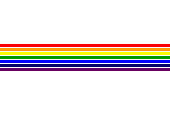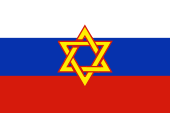Jüdisches Autonomes Gebiet |
|
|
|
| Übersicht – Contents: | |
Diese Seite ist Teil des Projektes
Jüdisches Autonomes Gebiet |
|
|
|
| Übersicht – Contents: | |
Flaggen – Flags: |
|
 |
Nationalflagge – national flag, Quelle/Source, nach/by: Flags of the World |
 |
inoffizielle Flagge – unofficial flag, Quelle/Source, nach/by: Flags of the World |
|
|
|
Bedeutung/Ursprung der Flagge – Meaning/Origin of the Flag: |
|
| Die offizielle Flagge der Jüdischen Autonomen Region zeigt die Farben des Regenbogens in schmalen, horizontalen Streifen in der Mitte eines weißen Grundtuches. Die Vielfarbigkeit des Regenbogens ist möglicherweise eine Anspielung auf die ethnische Vielfalt des Landes. Vor allem die jüdischen Landesbewohner nutzen die russische Flagge mit einem aufgelegten gelben Davidsstern, wohl um ihrer kulturellen Identität und ihrer Loyalität zu Russland Ausdruck zu verleihen. |
The official flag of the Jewish Autonomous Republic shows the colours of the
rainbow in narrow, horizontal stripes in the middle of a white bunting. The colorfulness of the rainbow is possibly a hint for the ethnic diversity of the land. Mostly the jewish residents use the russian flag with a uplayed yellow david-star, indeed to verbalize their cultural identity and their loyalty to Russia. |
| Quelle/Source: Flags of the World, Volker Preuß | |
|
|
|
Wappen – Coat of Arms: |
|
 |
Wappen Jüdisches Autonomes Gebiet – coat of arms of the Jewish Autonomous Oblast, Quelle/Source: By Hellerick [Public domain or CC BY-SA 3.0 ], from Wikimedia Commons |
|
|
|
Bedeutung/Ursprung des Wappens – Meaning/Origin of the Coat of Arms: |
|
| Das Wappen des Jüdischen Autonomen Gebiets ist ein grüner Wappenschild mit je einer weiß abgesetzten blauen Linie oben und unten. In der Mitte ein Amur-Tiger in Naturfarben. Die beiden blauen Linen stehen für die Flüsse Bira und Bidschan, das Grün für die Wälder (Taiga) und die Wiesen im Land. | The coat of arms of the Jewish Autonomous Region is a green escutcheon, each with a white deposed blue line above and below. In the middle an amur tiger in natural colors. The two blue lines stand for the rivers Bira and Bidshan, the green for the forests (taiga) and the meadows in the country. |
| Quelle/Source: Wikipedia (EN) | |
|
|
|
| Landkarte – Map: |
geographische Lage in Russland – geographical position within Russia: |
|
|
Zahlen und Fakten – Numbers and Facts: |
|
|
|
|
|
|
|
|
|
|
|
|
|
|
|
|
|
|
Geschichte: |
|
1689 · Vertrag von Nertschinsk, Russland und
China verzichten
gegenseitig auf den Erwerb des Gebietes 1728 · Vertrag von Kjachta, Russland und China verzichten erneut gegenseitig auf den Erwerb des Gebietes 1858 · das Gebiet kommt zu Russland 1918 · sowjetische Machtergreifung 1928 · das Gebiet wird zum Jüdischen Siedlungsgebiet erklärt 1934 · Gründung des Jüdischen Autonomen Oblast (Bezirk), der Anteil der Juden in der der Gesamtbevölkerung liegt bei 45% 1939 · der Anteil der Juden in der der Gesamtbevölkerung liegt bei 16% 1947 · Eröffnung der ersten Synagoge in Birobidschan 1948 · staatliche Repressionen gegen die Führer der jüdischen Kultur, antisemitische Kampagne gegen "Kosmopoliten" Frühjahr 1991 · der Jüdische Autonome Oblast erklärt sich zur Republik, nicht anerkannt 29.11.1991 · neue Verfassung, als Jüdische Autonome Region 31.12.1991 · die Sowjetunion löst sich auf, die Verfassung der Russischen Sozialistischen Föderativen Sowjetrepublik (RSFSR, Russland), ein ehemaliger Teilstaat der Sowjetunion bleibt vorerst in Kraft 25.12.1993 · eine neue Verfassung für Russland (Russische Föderation) tritt in Kraft, das Verhältnis zu den Gliedern der Föderation wird damit neu geregelt 2013 · erste Vorschläge zur Fusion der Jüdischen Autonomen Region mit angrenzenden Regionen |
|
|
History: |
|
1689 · Treaty of Nertshinsk, Russia and
China disclaim bilaterally
for the purchase of the territory 1728 · Treaty of von Kjakhta, Russia and China disclaim bilaterally again for the purchase of the territory 1858 · the territory comes to Russia 1918 · soviet takeover 1928 · the territory gets declared as Jewish settlement area 1934 · foundation of the Jewish Autonomous Oblast (district), the quota of Jews in the total population is 45% 1939 · the quota of Jews in the total population is 16% 1947 · opening of the first synagogue in Birobidzhan 1948 · repressions of the state against the leaders of Jewish culture, anti-Semitic campaign against "cosmopolitans" 1970-1990 · emigration of most of the Jewish population to Israel and Germany Spring 1991 · the Jewish Autonomous Oblast declares itself for a republic, not recognized 29th of November 1991 · new constitution, as Jewish Autonomous Oblast 31st of December in 1991 · the Soviet Union dissolves, the constitution of the Russian Socialist Federative Soviet Republic (RSFSR, Russia), a former substate of the Soviet Union, remains in force for the time being 25th of December in 1993 · a new constitution for Russia (Russian Federation) comes into force, and the relationships with the members of the federation is re-regulated in this way 2013 · initial proposals to merge the Jewish Autonomous Oblast with adjoining regions |
| Quelle/Source: Atlas zur Geschichte, Wikipedia (EN), World Statesmen, Russiatrek |
|
|